Human Resource Management Practices Essay: An Overview
VerifiedAdded on 2021/05/31
|7
|1766
|58
Essay
AI Summary
This essay provides a comprehensive overview of Human Resource Management (HRM) practices and their significance in today's business environment. It explores three key areas: retaining and developing talent and managing careers, reward management, and performance management. The essay emphasizes the importance of strategic HRM in aligning organizational objectives with employee needs. It discusses strategies for retaining skilled employees, such as creating a positive work environment and offering growth opportunities. The essay also examines performance management systems, including the transition from traditional methods to more effective approaches like quarterly performance snapshots. Finally, the essay addresses reward management, highlighting its role in motivating employees and driving high performance through both financial and non-financial rewards. The essay concludes by underscoring the importance of these HRM practices in achieving strategic business goals and fostering employee engagement.
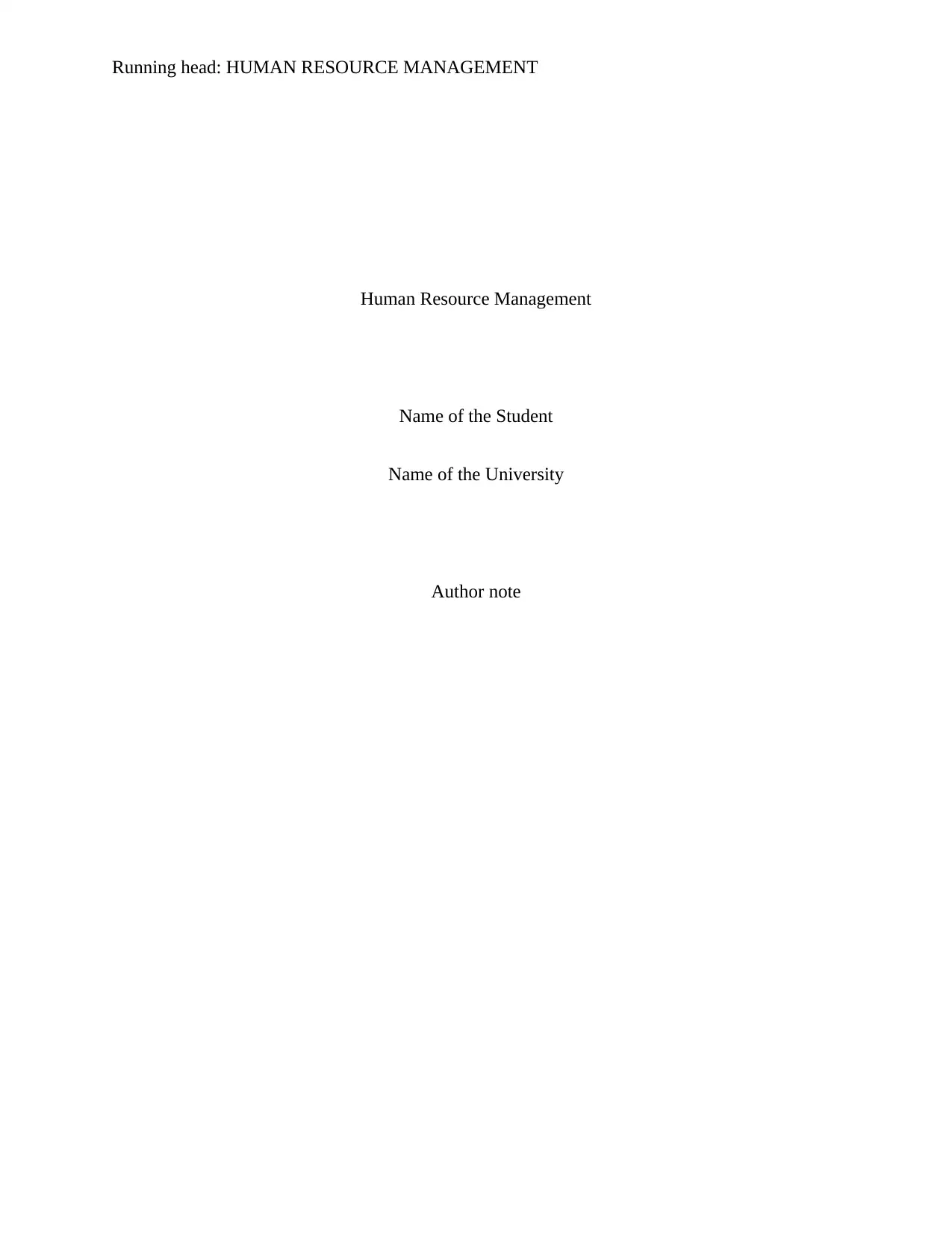
Running head: HUMAN RESOURCE MANAGEMENT
Human Resource Management
Name of the Student
Name of the University
Author note
Human Resource Management
Name of the Student
Name of the University
Author note
Paraphrase This Document
Need a fresh take? Get an instant paraphrase of this document with our AI Paraphraser
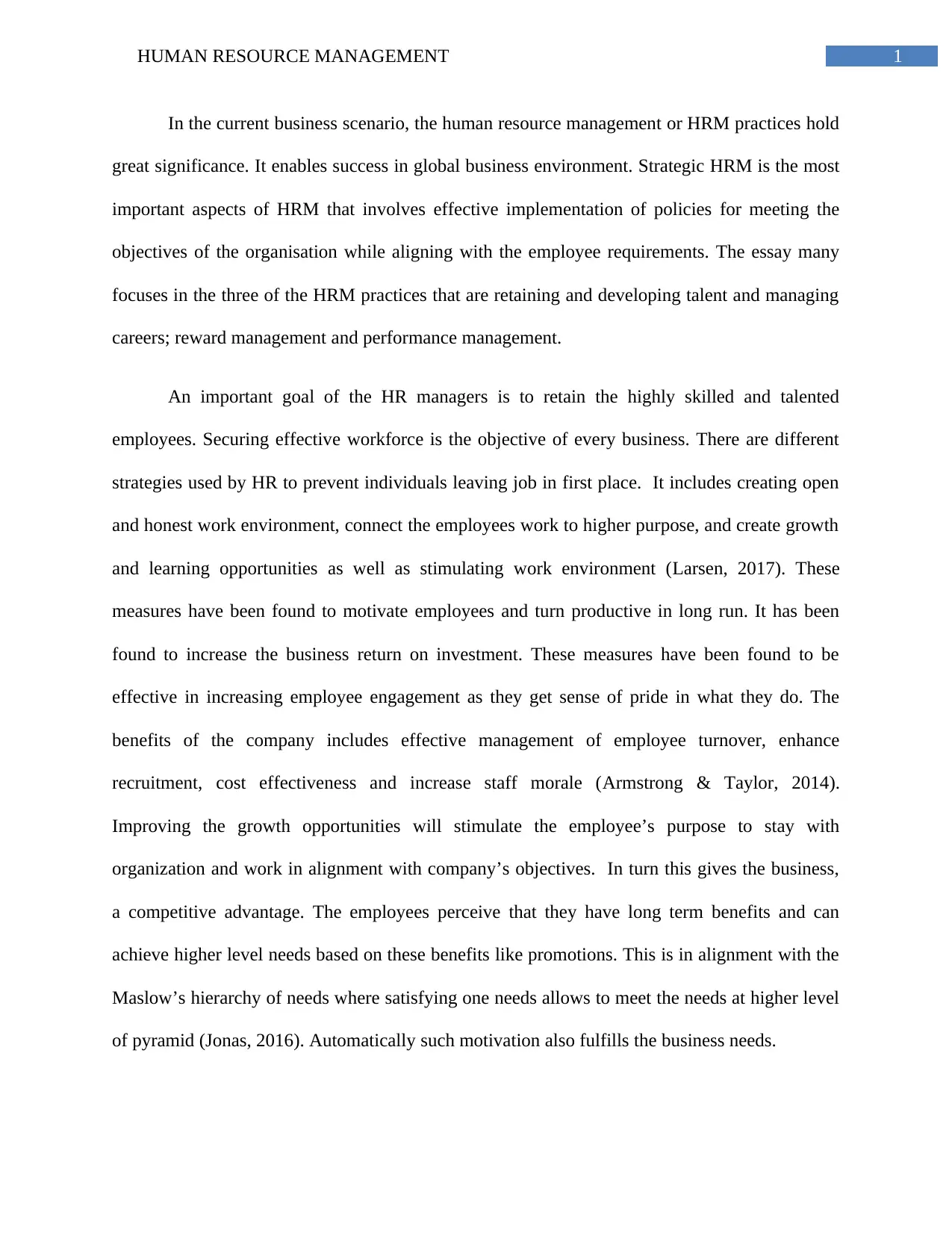
1HUMAN RESOURCE MANAGEMENT
In the current business scenario, the human resource management or HRM practices hold
great significance. It enables success in global business environment. Strategic HRM is the most
important aspects of HRM that involves effective implementation of policies for meeting the
objectives of the organisation while aligning with the employee requirements. The essay many
focuses in the three of the HRM practices that are retaining and developing talent and managing
careers; reward management and performance management.
An important goal of the HR managers is to retain the highly skilled and talented
employees. Securing effective workforce is the objective of every business. There are different
strategies used by HR to prevent individuals leaving job in first place. It includes creating open
and honest work environment, connect the employees work to higher purpose, and create growth
and learning opportunities as well as stimulating work environment (Larsen, 2017). These
measures have been found to motivate employees and turn productive in long run. It has been
found to increase the business return on investment. These measures have been found to be
effective in increasing employee engagement as they get sense of pride in what they do. The
benefits of the company includes effective management of employee turnover, enhance
recruitment, cost effectiveness and increase staff morale (Armstrong & Taylor, 2014).
Improving the growth opportunities will stimulate the employee’s purpose to stay with
organization and work in alignment with company’s objectives. In turn this gives the business,
a competitive advantage. The employees perceive that they have long term benefits and can
achieve higher level needs based on these benefits like promotions. This is in alignment with the
Maslow’s hierarchy of needs where satisfying one needs allows to meet the needs at higher level
of pyramid (Jonas, 2016). Automatically such motivation also fulfills the business needs.
In the current business scenario, the human resource management or HRM practices hold
great significance. It enables success in global business environment. Strategic HRM is the most
important aspects of HRM that involves effective implementation of policies for meeting the
objectives of the organisation while aligning with the employee requirements. The essay many
focuses in the three of the HRM practices that are retaining and developing talent and managing
careers; reward management and performance management.
An important goal of the HR managers is to retain the highly skilled and talented
employees. Securing effective workforce is the objective of every business. There are different
strategies used by HR to prevent individuals leaving job in first place. It includes creating open
and honest work environment, connect the employees work to higher purpose, and create growth
and learning opportunities as well as stimulating work environment (Larsen, 2017). These
measures have been found to motivate employees and turn productive in long run. It has been
found to increase the business return on investment. These measures have been found to be
effective in increasing employee engagement as they get sense of pride in what they do. The
benefits of the company includes effective management of employee turnover, enhance
recruitment, cost effectiveness and increase staff morale (Armstrong & Taylor, 2014).
Improving the growth opportunities will stimulate the employee’s purpose to stay with
organization and work in alignment with company’s objectives. In turn this gives the business,
a competitive advantage. The employees perceive that they have long term benefits and can
achieve higher level needs based on these benefits like promotions. This is in alignment with the
Maslow’s hierarchy of needs where satisfying one needs allows to meet the needs at higher level
of pyramid (Jonas, 2016). Automatically such motivation also fulfills the business needs.

2HUMAN RESOURCE MANAGEMENT
Performance management is an important process of reviewing the performance of the
employees in the preceding year and deciding where he or she stands when compared to their
peers in same band. It allows the HR managers to decide the salary hike in a particular appraisal
cycle (Shields et al., 2015). There are several measures to align the performance management to
meet the strategic business objectives and the employee needs.
Performance reviews and ratings are age old methods. The former is known to be
awkward and biased. Feedback involves long waiting times while the ratings are done
subjectively without input from people being evaluated. Since performance is the value of
employees' contributions to the organization over time, there must be formal evaluations (Goler,
Gale & Grant, 2016). There was no better solution found after ditching the methods like 360
degree, rankings and even annual reviews. The conventional wisdom of performance
management is questioned by HR managers as well as employees. It calls for the strategic HRM
practice that will help recognise the varying performance and clearly view the same anytime for
boosting the performance. Applying the Theory X, a hard model can be used for varying
employee needs based on control and economic model. According to Theory Y, soft model is
based on commitment and control (Clegg, Kornberger & Pitsis, 2015).
The strategic HRM practice of Deolitte effectively addressed this issue by performance
snapshot taken quarterly or per project allowing greater engagement with people. In this simple
measure of the Deolitte the rater can rates own actions instead of the qualities of the ratee. The
questions may be designed for promotion, teamwork, pay and about poor performance in
alignment with theory of X and Y. To ensure charity and simplicity the rater can be chosen from
team leaders as they are closest to the employees. Further, Deolitte focuses on the validity
testing and transparency (Buckingham & Goodall, 2015). Such effective performance
Performance management is an important process of reviewing the performance of the
employees in the preceding year and deciding where he or she stands when compared to their
peers in same band. It allows the HR managers to decide the salary hike in a particular appraisal
cycle (Shields et al., 2015). There are several measures to align the performance management to
meet the strategic business objectives and the employee needs.
Performance reviews and ratings are age old methods. The former is known to be
awkward and biased. Feedback involves long waiting times while the ratings are done
subjectively without input from people being evaluated. Since performance is the value of
employees' contributions to the organization over time, there must be formal evaluations (Goler,
Gale & Grant, 2016). There was no better solution found after ditching the methods like 360
degree, rankings and even annual reviews. The conventional wisdom of performance
management is questioned by HR managers as well as employees. It calls for the strategic HRM
practice that will help recognise the varying performance and clearly view the same anytime for
boosting the performance. Applying the Theory X, a hard model can be used for varying
employee needs based on control and economic model. According to Theory Y, soft model is
based on commitment and control (Clegg, Kornberger & Pitsis, 2015).
The strategic HRM practice of Deolitte effectively addressed this issue by performance
snapshot taken quarterly or per project allowing greater engagement with people. In this simple
measure of the Deolitte the rater can rates own actions instead of the qualities of the ratee. The
questions may be designed for promotion, teamwork, pay and about poor performance in
alignment with theory of X and Y. To ensure charity and simplicity the rater can be chosen from
team leaders as they are closest to the employees. Further, Deolitte focuses on the validity
testing and transparency (Buckingham & Goodall, 2015). Such effective performance
⊘ This is a preview!⊘
Do you want full access?
Subscribe today to unlock all pages.

Trusted by 1+ million students worldwide
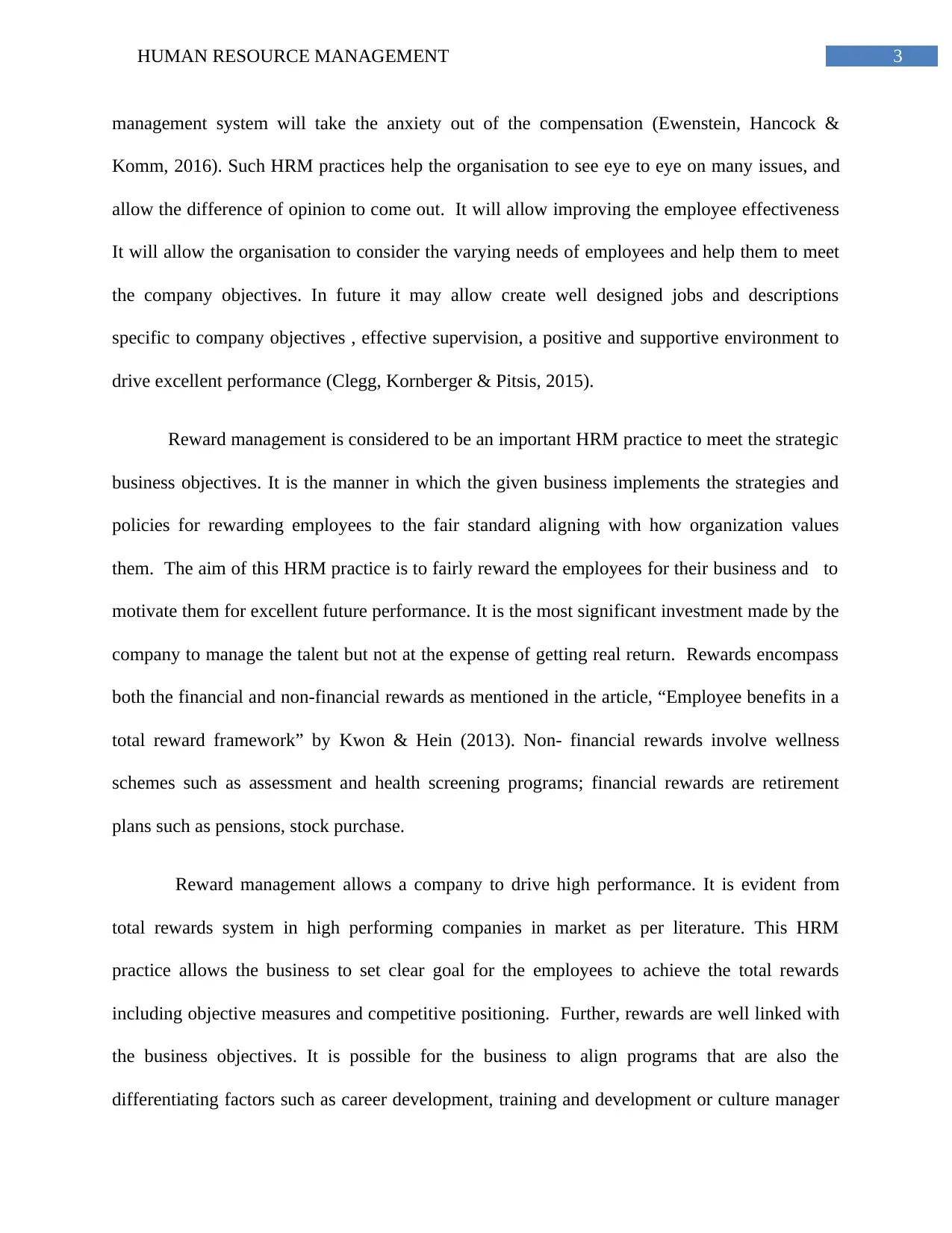
3HUMAN RESOURCE MANAGEMENT
management system will take the anxiety out of the compensation (Ewenstein, Hancock &
Komm, 2016). Such HRM practices help the organisation to see eye to eye on many issues, and
allow the difference of opinion to come out. It will allow improving the employee effectiveness
It will allow the organisation to consider the varying needs of employees and help them to meet
the company objectives. In future it may allow create well designed jobs and descriptions
specific to company objectives , effective supervision, a positive and supportive environment to
drive excellent performance (Clegg, Kornberger & Pitsis, 2015).
Reward management is considered to be an important HRM practice to meet the strategic
business objectives. It is the manner in which the given business implements the strategies and
policies for rewarding employees to the fair standard aligning with how organization values
them. The aim of this HRM practice is to fairly reward the employees for their business and to
motivate them for excellent future performance. It is the most significant investment made by the
company to manage the talent but not at the expense of getting real return. Rewards encompass
both the financial and non-financial rewards as mentioned in the article, “Employee benefits in a
total reward framework” by Kwon & Hein (2013). Non- financial rewards involve wellness
schemes such as assessment and health screening programs; financial rewards are retirement
plans such as pensions, stock purchase.
Reward management allows a company to drive high performance. It is evident from
total rewards system in high performing companies in market as per literature. This HRM
practice allows the business to set clear goal for the employees to achieve the total rewards
including objective measures and competitive positioning. Further, rewards are well linked with
the business objectives. It is possible for the business to align programs that are also the
differentiating factors such as career development, training and development or culture manager
management system will take the anxiety out of the compensation (Ewenstein, Hancock &
Komm, 2016). Such HRM practices help the organisation to see eye to eye on many issues, and
allow the difference of opinion to come out. It will allow improving the employee effectiveness
It will allow the organisation to consider the varying needs of employees and help them to meet
the company objectives. In future it may allow create well designed jobs and descriptions
specific to company objectives , effective supervision, a positive and supportive environment to
drive excellent performance (Clegg, Kornberger & Pitsis, 2015).
Reward management is considered to be an important HRM practice to meet the strategic
business objectives. It is the manner in which the given business implements the strategies and
policies for rewarding employees to the fair standard aligning with how organization values
them. The aim of this HRM practice is to fairly reward the employees for their business and to
motivate them for excellent future performance. It is the most significant investment made by the
company to manage the talent but not at the expense of getting real return. Rewards encompass
both the financial and non-financial rewards as mentioned in the article, “Employee benefits in a
total reward framework” by Kwon & Hein (2013). Non- financial rewards involve wellness
schemes such as assessment and health screening programs; financial rewards are retirement
plans such as pensions, stock purchase.
Reward management allows a company to drive high performance. It is evident from
total rewards system in high performing companies in market as per literature. This HRM
practice allows the business to set clear goal for the employees to achieve the total rewards
including objective measures and competitive positioning. Further, rewards are well linked with
the business objectives. It is possible for the business to align programs that are also the
differentiating factors such as career development, training and development or culture manager
Paraphrase This Document
Need a fresh take? Get an instant paraphrase of this document with our AI Paraphraser
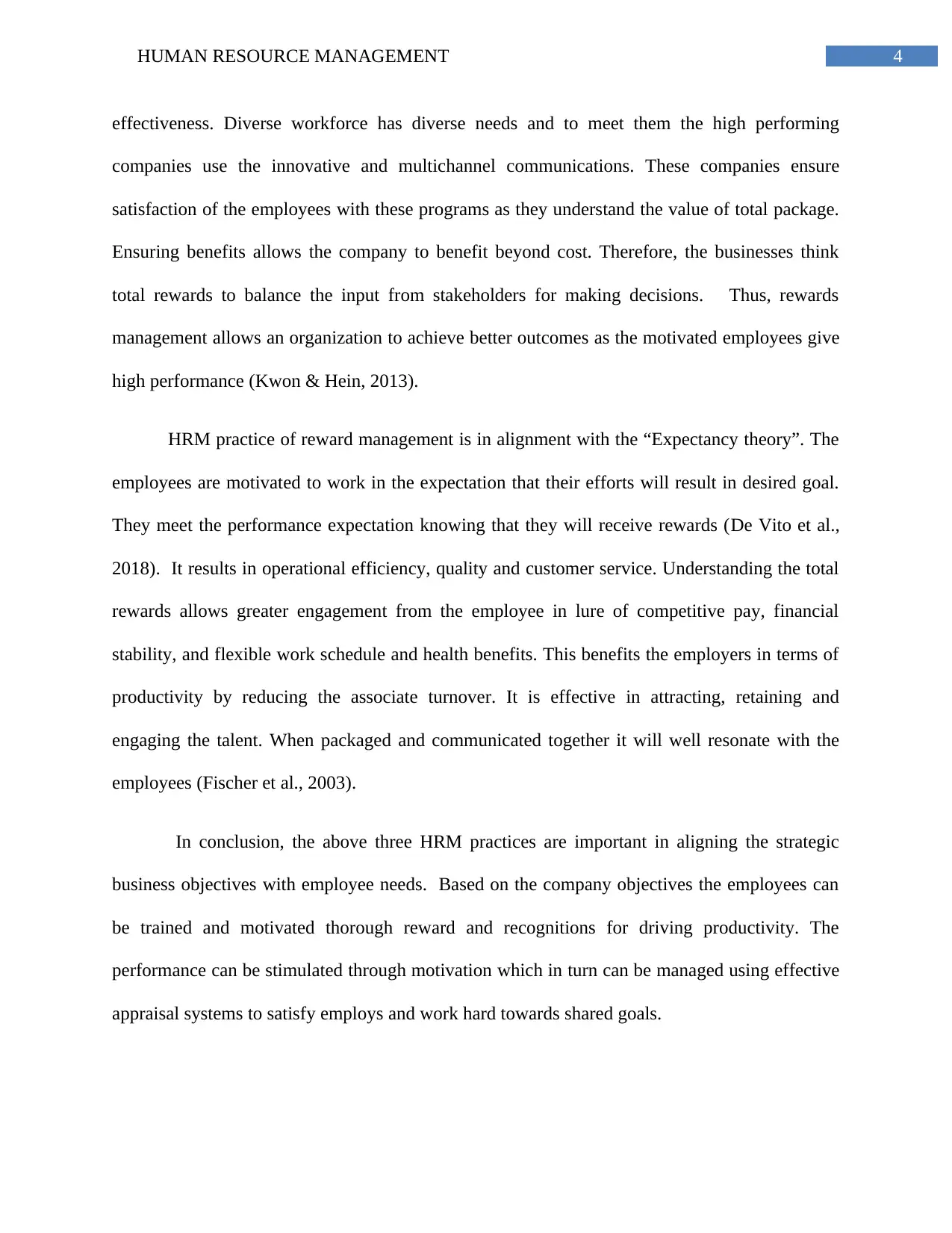
4HUMAN RESOURCE MANAGEMENT
effectiveness. Diverse workforce has diverse needs and to meet them the high performing
companies use the innovative and multichannel communications. These companies ensure
satisfaction of the employees with these programs as they understand the value of total package.
Ensuring benefits allows the company to benefit beyond cost. Therefore, the businesses think
total rewards to balance the input from stakeholders for making decisions. Thus, rewards
management allows an organization to achieve better outcomes as the motivated employees give
high performance (Kwon & Hein, 2013).
HRM practice of reward management is in alignment with the “Expectancy theory”. The
employees are motivated to work in the expectation that their efforts will result in desired goal.
They meet the performance expectation knowing that they will receive rewards (De Vito et al.,
2018). It results in operational efficiency, quality and customer service. Understanding the total
rewards allows greater engagement from the employee in lure of competitive pay, financial
stability, and flexible work schedule and health benefits. This benefits the employers in terms of
productivity by reducing the associate turnover. It is effective in attracting, retaining and
engaging the talent. When packaged and communicated together it will well resonate with the
employees (Fischer et al., 2003).
In conclusion, the above three HRM practices are important in aligning the strategic
business objectives with employee needs. Based on the company objectives the employees can
be trained and motivated thorough reward and recognitions for driving productivity. The
performance can be stimulated through motivation which in turn can be managed using effective
appraisal systems to satisfy employs and work hard towards shared goals.
effectiveness. Diverse workforce has diverse needs and to meet them the high performing
companies use the innovative and multichannel communications. These companies ensure
satisfaction of the employees with these programs as they understand the value of total package.
Ensuring benefits allows the company to benefit beyond cost. Therefore, the businesses think
total rewards to balance the input from stakeholders for making decisions. Thus, rewards
management allows an organization to achieve better outcomes as the motivated employees give
high performance (Kwon & Hein, 2013).
HRM practice of reward management is in alignment with the “Expectancy theory”. The
employees are motivated to work in the expectation that their efforts will result in desired goal.
They meet the performance expectation knowing that they will receive rewards (De Vito et al.,
2018). It results in operational efficiency, quality and customer service. Understanding the total
rewards allows greater engagement from the employee in lure of competitive pay, financial
stability, and flexible work schedule and health benefits. This benefits the employers in terms of
productivity by reducing the associate turnover. It is effective in attracting, retaining and
engaging the talent. When packaged and communicated together it will well resonate with the
employees (Fischer et al., 2003).
In conclusion, the above three HRM practices are important in aligning the strategic
business objectives with employee needs. Based on the company objectives the employees can
be trained and motivated thorough reward and recognitions for driving productivity. The
performance can be stimulated through motivation which in turn can be managed using effective
appraisal systems to satisfy employs and work hard towards shared goals.
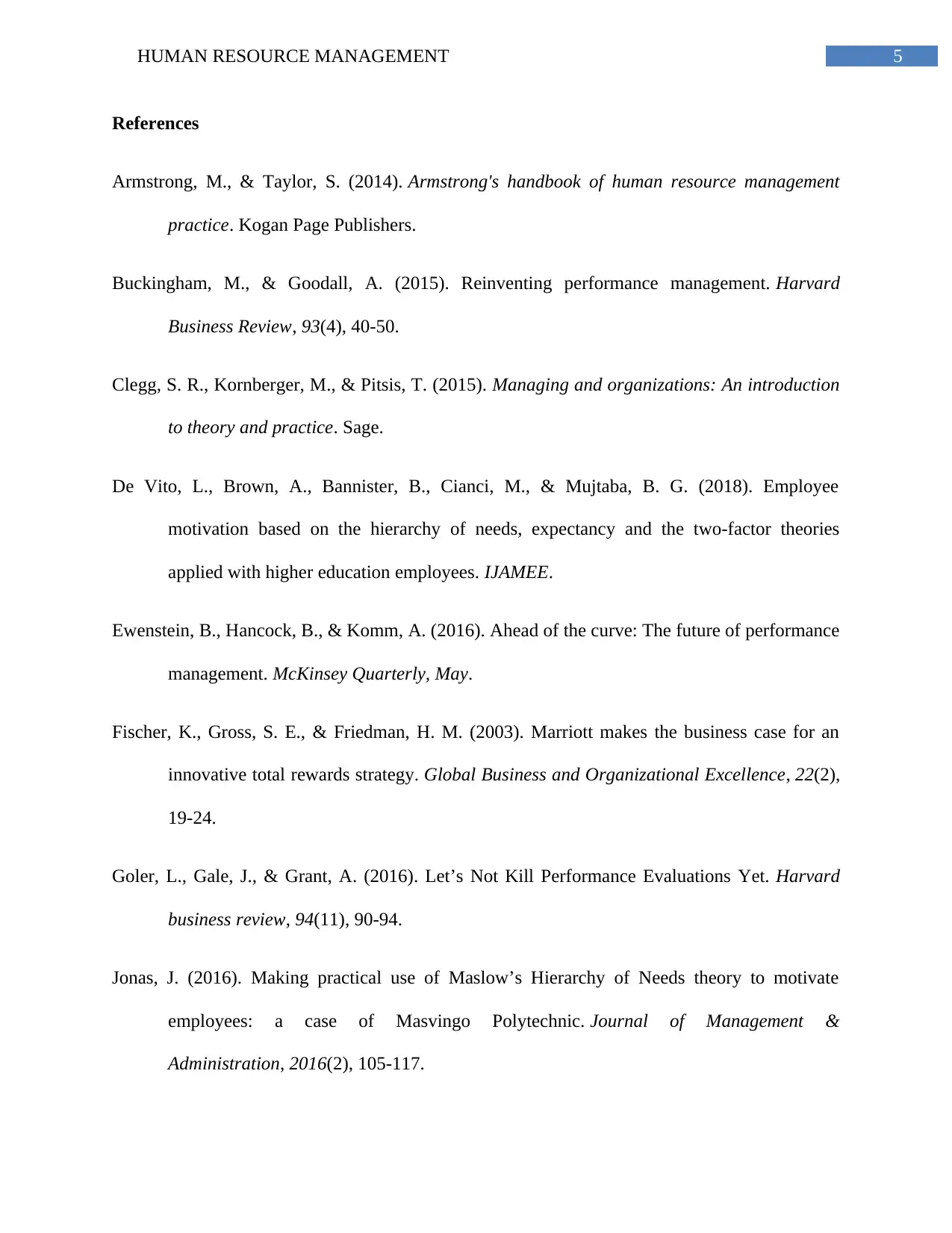
5HUMAN RESOURCE MANAGEMENT
References
Armstrong, M., & Taylor, S. (2014). Armstrong's handbook of human resource management
practice. Kogan Page Publishers.
Buckingham, M., & Goodall, A. (2015). Reinventing performance management. Harvard
Business Review, 93(4), 40-50.
Clegg, S. R., Kornberger, M., & Pitsis, T. (2015). Managing and organizations: An introduction
to theory and practice. Sage.
De Vito, L., Brown, A., Bannister, B., Cianci, M., & Mujtaba, B. G. (2018). Employee
motivation based on the hierarchy of needs, expectancy and the two-factor theories
applied with higher education employees. IJAMEE.
Ewenstein, B., Hancock, B., & Komm, A. (2016). Ahead of the curve: The future of performance
management. McKinsey Quarterly, May.
Fischer, K., Gross, S. E., & Friedman, H. M. (2003). Marriott makes the business case for an
innovative total rewards strategy. Global Business and Organizational Excellence, 22(2),
19-24.
Goler, L., Gale, J., & Grant, A. (2016). Let’s Not Kill Performance Evaluations Yet. Harvard
business review, 94(11), 90-94.
Jonas, J. (2016). Making practical use of Maslow’s Hierarchy of Needs theory to motivate
employees: a case of Masvingo Polytechnic. Journal of Management &
Administration, 2016(2), 105-117.
References
Armstrong, M., & Taylor, S. (2014). Armstrong's handbook of human resource management
practice. Kogan Page Publishers.
Buckingham, M., & Goodall, A. (2015). Reinventing performance management. Harvard
Business Review, 93(4), 40-50.
Clegg, S. R., Kornberger, M., & Pitsis, T. (2015). Managing and organizations: An introduction
to theory and practice. Sage.
De Vito, L., Brown, A., Bannister, B., Cianci, M., & Mujtaba, B. G. (2018). Employee
motivation based on the hierarchy of needs, expectancy and the two-factor theories
applied with higher education employees. IJAMEE.
Ewenstein, B., Hancock, B., & Komm, A. (2016). Ahead of the curve: The future of performance
management. McKinsey Quarterly, May.
Fischer, K., Gross, S. E., & Friedman, H. M. (2003). Marriott makes the business case for an
innovative total rewards strategy. Global Business and Organizational Excellence, 22(2),
19-24.
Goler, L., Gale, J., & Grant, A. (2016). Let’s Not Kill Performance Evaluations Yet. Harvard
business review, 94(11), 90-94.
Jonas, J. (2016). Making practical use of Maslow’s Hierarchy of Needs theory to motivate
employees: a case of Masvingo Polytechnic. Journal of Management &
Administration, 2016(2), 105-117.
⊘ This is a preview!⊘
Do you want full access?
Subscribe today to unlock all pages.

Trusted by 1+ million students worldwide
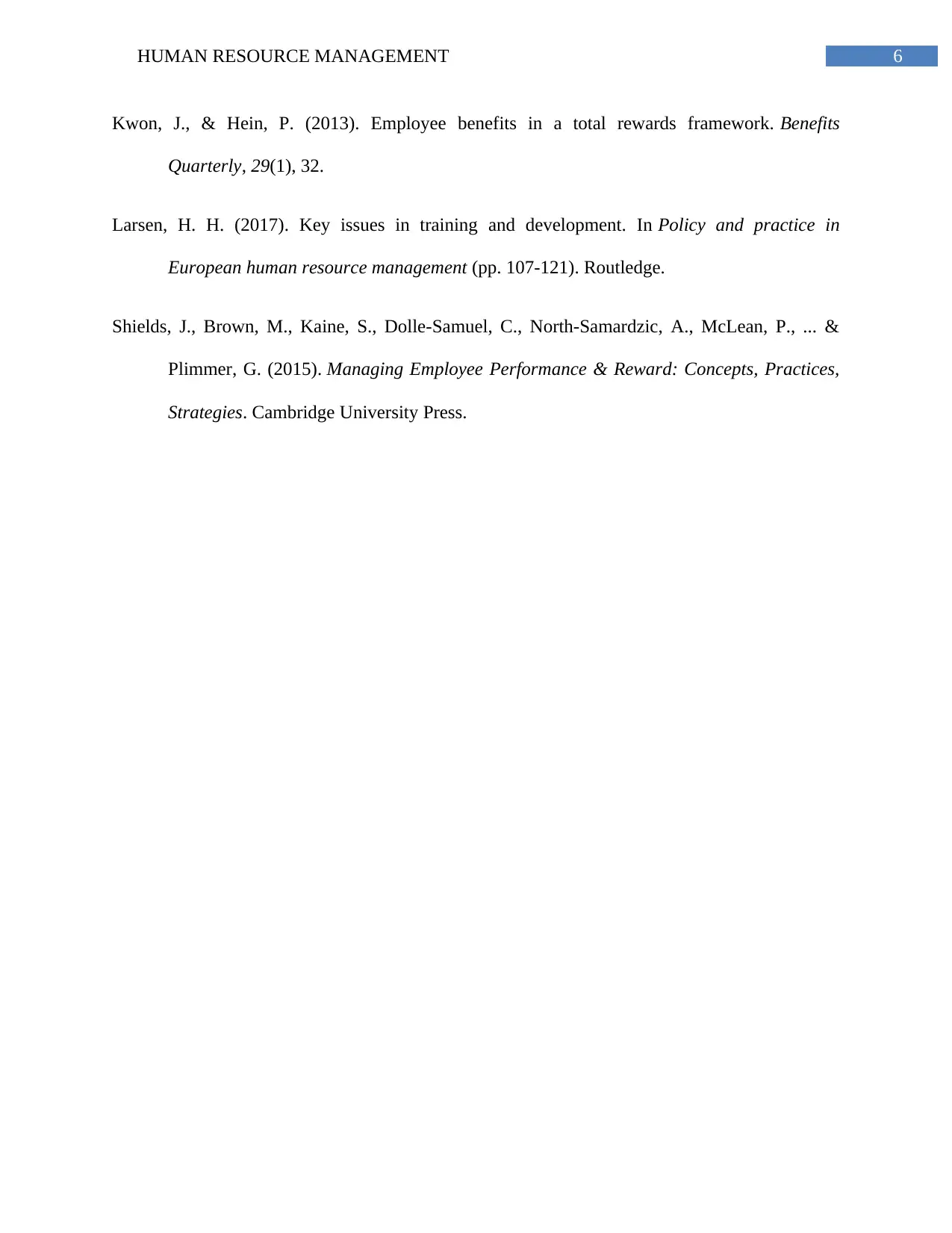
6HUMAN RESOURCE MANAGEMENT
Kwon, J., & Hein, P. (2013). Employee benefits in a total rewards framework. Benefits
Quarterly, 29(1), 32.
Larsen, H. H. (2017). Key issues in training and development. In Policy and practice in
European human resource management (pp. 107-121). Routledge.
Shields, J., Brown, M., Kaine, S., Dolle-Samuel, C., North-Samardzic, A., McLean, P., ... &
Plimmer, G. (2015). Managing Employee Performance & Reward: Concepts, Practices,
Strategies. Cambridge University Press.
Kwon, J., & Hein, P. (2013). Employee benefits in a total rewards framework. Benefits
Quarterly, 29(1), 32.
Larsen, H. H. (2017). Key issues in training and development. In Policy and practice in
European human resource management (pp. 107-121). Routledge.
Shields, J., Brown, M., Kaine, S., Dolle-Samuel, C., North-Samardzic, A., McLean, P., ... &
Plimmer, G. (2015). Managing Employee Performance & Reward: Concepts, Practices,
Strategies. Cambridge University Press.
1 out of 7
Related Documents
Your All-in-One AI-Powered Toolkit for Academic Success.
+13062052269
info@desklib.com
Available 24*7 on WhatsApp / Email
![[object Object]](/_next/static/media/star-bottom.7253800d.svg)
Unlock your academic potential
Copyright © 2020–2025 A2Z Services. All Rights Reserved. Developed and managed by ZUCOL.



